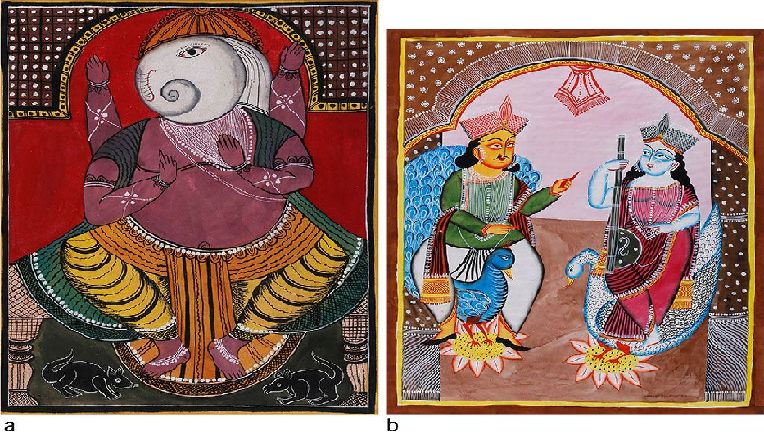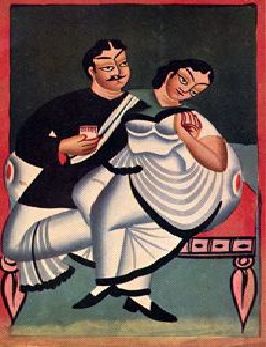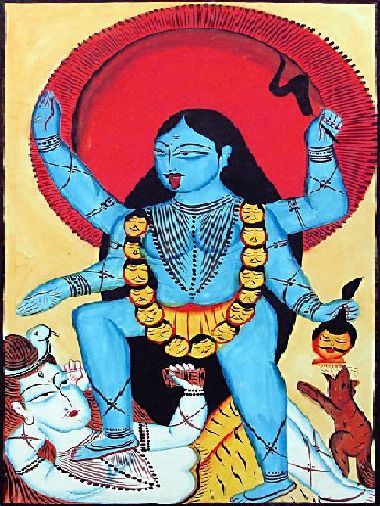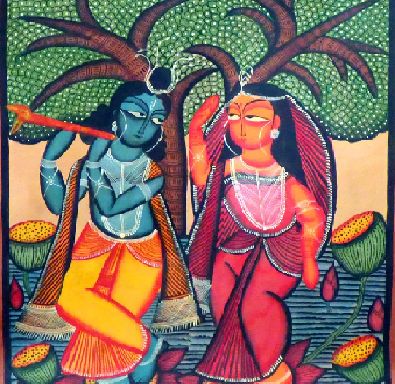Kalighat Paintings
Sep 28, 2019 • 1656 views
History of the Paintings
Dating back to the 19th century, the origin of Kalighat paintings also known as Kalighat Pat took place in West Bengal, particularly in the region of Kalighat in Calcutta. Kalighat paintings were a result of a number of inner and outer influences that acted on the traditional art form to evolve and give birth to a new one. At the start of the 19th century, the traditional art form of scroll paintings was the only popular one in Bengal. It was usually done by villagers called patuas who used to roam from place to place with their scroll paintings. With the passage of time, Britishers set up their own school of art which used to train Indian artists in the European style of painting. The patuas who were masters in scroll paintings also started going to these institutions. Out of all the schools, the Calcutta School of Art was one of the major ones and thus attracted a good number of people. These artisans then settled near the Kalighat Temple where they tried new techniques and styles to produce religious art. This gave birth to what we know as the Kalighat style of painting.

Kalighat Painting - Source: Must Art Gallery
Disciplines of Kalighat Paintings
Kalighat Paintings can be divided into two different styles - Oriental style and Occidental style, based particularly on the varied motifs and themes that are being used in both types.
Oriental Style - The word ‘oriental’ literally means something belonging to Asia and thus being true to its meaning, this style of painting derives its ideas and themes from religious and mythological tales of the Indian culture. The very fact that these paintings came into existence near the Kalighat temple makes it even more relevant to have such themes. The paintings very beautifully present various Gods and Goddesses of the Hindu religion. Some of the most common figures in these paintings include that of Lord Shiva, Goddess Parvati, Saraswati, Kali, etc. Apart from these figures, the artists also drew scenes from various mythological tales and epics such as Ramayana and Mahabharata.

Oriental Kalighat Painting - Source: Story Ltd
Occidental Style - Occidental basically refers to something that is from the West. In these paintings instead of religious themes, drawings depicting incidents from everyday life are drawn. Whether it is the satirical depiction of Babu culture in Bengal or representation of regular household activities, through Occidental style of Kalighat painting, the artists captured everything that intrigued them.

Occidental Kalighat Painting - Source: Banglapedia
Methods and Variations
Kalighat paintings were executed using simple tools and techniques. Considering the times that these paintings were born, all the basic requirements for making the paintings were fulfilled using natural sources that were easily available in the surroundings. The paints were made using natural dyes and various indigenous materials such as turmeric, flowers, soot from an oil lamp, etc. The brushes were usually made out of Goat’s tail or squirrel’s hair.
Following are some of the basic steps employed in the making of Kalighat paintings-
The very first step is to gather the paints that are to be used in the painting. Earlier paints were made at home by grinding different ingredients and then creating dyes out of them but with the passage of time, these homemade colors were replaced by the synthetic paints available in the market and these are the ones which are used even today.
Next comes the design. First, a rough sketch is drawn with a pencil which is them later copied on the actual material.
Followed by sketching, drawing, and contouring is the step that comes next.
The last step is to fill in the final colors in the figures as well as the background. This step is then finished by making a black outline.
Themes and Inspiration
Kalighat paintings being of the traditional folk art forms of Bengal derives inspiration from religious and mythological stories as well as everyday elements of life. Most of these paintings following their central theme of religion and life present various kinds of depictions of religious figures such as Goddess Durga, Lakshmi, Lord Shiva, etc. The scenes of Ram and Sita taken from Ramayana as well those of Lord Krishna in his childhood and adulthood are beautifully depicted in these paintings. They captured the essence of life and told the stories of the changing Bengal through paintings of freedom fighters as well as that of the crimes and atrocities that were taking place in the region.

Painting Showing Goddess Kali - Source: Dolls Of India

Painting Showing Radha and Krishna - Source: Indian Craft House
Kalighat Paintings in the Contemporary World
Kalighat paintings are one of the well known Indian art forms. They have been amazing people with their beauty and depiction of reality for many years and have still retained their essence. With the changing times, these paintings have not only reached people in their authentic form but also with various modifications. Currently, the designs of these paintings can be seen of different products such as Sarees, Kurtis as well as various home decor elements.
Global Influence
Kalighat paintings from a small region in Bengal have managed to spread worldwide inspiring and awing people in different parts of the globe. From Kalighat paintings to their designs on different products, all of them are shipped overseas. The paintings hold global significance for they are to date preserved in many museums in different places like Britain and Philadelphia.
Interesting Facts
The making of Kalighat paintings was more of a family tradition where each member of the family would be involved in various steps to make just one painting.
Despite these paintings being an Indian art form, their largest collection is stored in the Victoria and Albert Museum in London.
Earlier, the artisans used to sing the stories that had been depicted in their paintings so as to attract customers.
